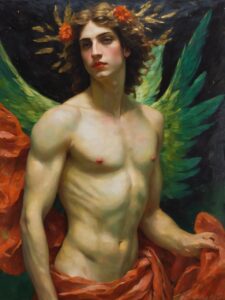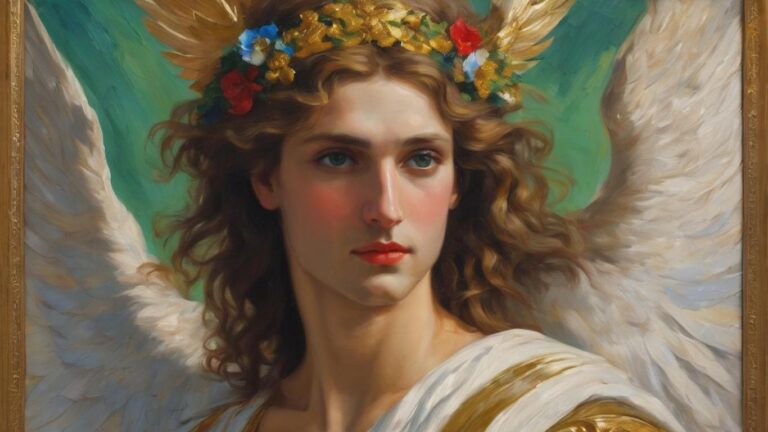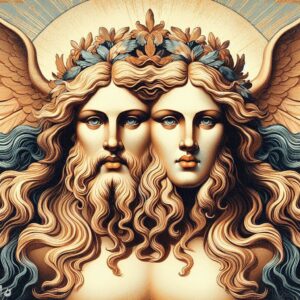Table of Contents
In Greek mythology, Ganymede was a divine figure, considered to be the most beautiful of mortals. He was the son of Tros, the king of Troy. The mythological story of Ganymede is primarily associated with his abduction by Zeus, the king of the gods.
Appearance

Ganymede, radiant and fair, possessed an otherworldly beauty that surpassed all mortals. His features were delicate, with eyes reflecting the hues of the sky. His golden hair cascaded like sunlit strands, framing a face that embodied divine perfection.
Transitioning from earthly youth to celestial cupbearer, Ganymede’s form became ageless and ethereal. The gods themselves marveled at the transformation, as he moved with a grace that mirrored the dance of the constellations.
His attire, woven from celestial fabrics, shimmered with iridescence. Each step he took left a subtle trail of stardust, marking his passage through the divine halls. Ganymede’s presence radiated an aura of timeless beauty, captivating all who beheld him.
As the cupbearer of Mount Olympus, his countenance mirrored the joy of the gods. His laughter echoed like celestial music, resonating through the divine abode. The gods, in their immortal splendor, found solace in the enchanting presence of Ganymede.
Transitioning seamlessly between mortal and immortal realms, Ganymede’s appearance symbolized the fusion of beauty and divinity. Mortals below, gazing at the night sky, saw his legacy immortalized in the constellation Aquarius—a reminder of a mortal youth blessed with an everlasting celestial allure.
The Myth
Long ago, in ancient Troy, Tros, the wise king, had a son named Ganymede. Known for unmatched beauty, Ganymede caught the attention of Zeus, the king of gods. Intrigued, Zeus transformed into an eagle, swiftly swooping down to abduct Ganymede.
In an instant, Ganymede found himself lifted to Mount Olympus. The divine realm unfolded before him, and he became the cupbearer to the gods. This unexpected ascension brought both awe and jealousy among the immortals.
Ganymede’s days were spent in the divine company, pouring nectar and ambrosia for the gods. His beauty and grace earned him the favor of the entire Olympian assembly. The mortal youth, now immortal, flourished in his celestial role.
Transitioning from a mortal life to a godly existence was a transition filled with challenges. Ganymede adapted, finding purpose and honor in his new responsibilities. His presence brought an ethereal touch to the heavenly banquets.
As time unfolded on Mount Olympus, Ganymede’s tale became legendary. Mortals marveled at the story of a youth plucked from Troy’s soil to become the cupbearer of the mighty gods. The skies immortalized him as the constellation Aquarius, forever pouring celestial waters.
In the divine tapestry of Greek mythology, Ganymede’s origin stood as a testament to the unpredictable ways in which mortal lives could intertwine with the whims of the gods.
Modern Culture

In modern culture, references to Ganymede can be found in various forms of art, literature, and popular media. Here are a few examples:
Literature:A
The novel “Ganymede” by Chico Buarque explores themes of identity and self-discovery, drawing inspiration from the mythological figure.
Art and Music:
Numerous paintings and sculptures depict the abduction of Ganymede, with artists like Michelangelo and Rubens capturing the myth in their works.
The song “Ganymede” by The Brian Jonestown Massacre is an example of how contemporary music sometimes draws on mythological themes.
Film and Television:
The character Ganymede is referenced in the science fiction series “The Expanse,” where Ganymede is a major location in the storyline.
The animated series “Sailor Moon” features a character named Sailor Ganymede, drawing inspiration from the myth.
Fashion and Design:
Ganymede’s association with beauty and grace occasionally influences fashion and design, with designers drawing inspiration from classical aesthetics.
Astronomy:
In astronomy, Ganymede is not only a mythological figure but also the largest moon of Jupiter. Space missions, like the Galileo spacecraft, have provided valuable insights into this celestial body.
Video Games:
Some video games incorporate characters or elements inspired by Ganymede. For instance, in the game “Destiny 2,” there’s a location called the “Garden of Esila,” which references Ganymede’s association with gardens.
These examples highlight how the myth of Ganymede continues to resonate in contemporary culture, demonstrating its enduring influence across different artistic and creative mediums.
FAQ
What moon is Ganymede?
Ganymede is one of Jupiter's moons and is the largest moon in our solar system.
Is Ganymede Zeus' lover?
In Greek mythology, Zeus abducted Ganymede to serve as a cupbearer, and while there are romantic elements in the myth, it is not explicitly described as a romantic relationship.
What is Ganymede's age?
In Greek mythology, Ganymede is described as a youthful and exceptionally beautiful mortal. However, specific details about his age are not provided in the myth.




